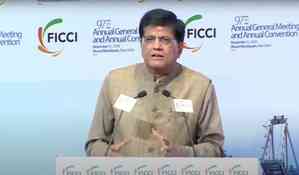The momentum in the infrastructure and real-estate industry will help building material industry register a 10% growth in 2023 states, Aparna Enterprises Ltd
2022 was the year of rebound for the building material industry. The thrust on infrastructure development coupled with the frenzy to own real-estate assets helped the industry to bounce back strongly.

2022 was the year of rebound for the building material industry. The thrust on infrastructure development coupled with the frenzy to own real-estate assets helped the industry to bounce back strongly. The building material industry sprung back and got closer to the pre-covid levels. The sector registered a growth of 10% in 2022. As we are moving towards 2023 the industry is showing no signs of slowing down rather it is heading towards significant growth. Growth of building material sector is very vital for the overall economy as it contributes nearly 9% to our countries GDP employing over 51 million people.
According to the Infrastructure and Project Monitoring Division of the Ministry of Statistics and Program Implementation (MoSPI), as of May 1, 2022, the country had 1,559 projects in the pipeline, worth INR 26.7 trillion ($352.3 billion). While a percentage of that may have neared completion, as they are major projects they are still in the pipeline indicating a huge potential for the building material industry. Another key factors that is adding to the momentum is the growth in residential and commercial real-estate. 2023 is expected to see a significant rise in new projects across the country leading to an increase in demand for building materials. Home is increasingly been viewed as a must have and as a long-term security even by the millennials of today. Post pandemic, even the luxury home market has gained attractive investments. This may demand use of quality and sturdy building material. Further, the growing consciousness from both corporates as well as individuals to adopt greener way of life is also boosting the sector. The industry is expected to record a double digit growth in 2023.
Mr. Ashwin Reddy, Managing Director, Aparna Enterprises added, “The Govt’s vision to be a $ 5 trillion economy and the resultant investments in infrastructure is a key factor driving the growth of the sector. Be it the National Infrastructure Pipeline (NIP), Pradhan Mantri Gati Shakti National Master Plan; the impact on building material industry looks optimistic. From a sub-sector point of view, RMC, uPVC window and door systems, Tiles and manufactured sand are expected to be the biggest gainers as more and more customers are looking for alternates that reduce the usage of natural resources. For instance, manufactured sand or robo sand is a very good alternate for river sand and adoption of this helps in reducing mining of sand for construction. Similarly uPVC window and door system is a good alternate for wooden window and doors.“
The industry has a huge market potential, however, for it to realise this opportunity will require a comprehensive effort from all the stakeholders including government. The RMC market in India is currently pegged at USD 25 Billion and is expected to see average of more than 15% growth in the next 4 years. uPVC is also not far behind, the demand of which is expected to rise 11% per year and reach $7.3 billion industry by 2025. One of the critical aspects that will require immediate attention would be inflation. Due to supply chain disruption and several tax by state government cost of raw material is on a rise. Government would need to rationalize the Indirect tax structure by including the Natural Gas and petroleum products under GST and also by reducing the tax rate on Building materials like cement which is under highest tax rate of 28% etc. to control the growing inflation. Increasing labour and raw material cost is an outcome of the inflation. Once that is under control, the costs also can be bought to a situation that is affordable for players operating in the space. Secondly, the increase in interest rate is also a critical aspect impacting the segment, hence the Government may look into reducing the interest rates once the inflation normalizes/come under control. In the meantime Interest subsidies may be provided to the manufacturers of essential building materials to tackle abnormal increase in the cost of production. Thirdly, lack of skilled manpower is lingering pain. According to Statista, construction industry had the highest shortage of skilled labour of about 85% in 2022. Therefore a full proof plan is required to train the manpower for future requirement. Lastly, multiple clearances required in any real-estate or infrastructure project added to the already existing challenges of the category players.
While lot of interventions have been undertaken by the Indian government in the last 2-3 years to aid growth of building materials industry, a lot of pending challenges still requires attention for a better future.


 City Air News
City Air News 











